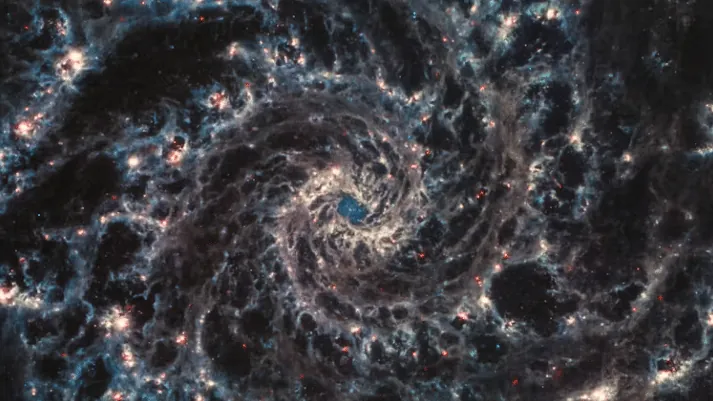
The James Webb Telescope Turns 3: Revelations That Are Changing Our Understanding of the Universe!
2024-12-27
Author: Yu
Three years ago today, we witnessed the awe-inspiring launch of the James Webb Space Telescope (JWST), the most powerful telescope ever sent into space. This astronomical marvel took three decades to build, and since its operation began, it has profoundly reshaped our understanding of the universe and our place within it.
In just three years, JWST has made groundbreaking discoveries that span from our own Solar System to the furthest reaches of the cosmos, unveiling insights into the early formation of stars and galaxies. Here’s a deep dive into what we've learned and the profound mysteries that still beckon us.
Galactic Giants: Eerie Blue Monsters
JWST has extended our observational reach into the cosmos, allowing us to glimpse galaxies that formed only 300 million years post-Big Bang. The current record-breaking galaxy it identified isn't just any distant nebula; it boasts an astonishing mass—roughly 400 million times that of our Sun—indicating an unprecedented rate of star formation in the early universe.
Most intriguingly, JWST has observed these early galaxies to be remarkably bright and blue, with no evidence of the dust typically produced by stellar explosions. This raises compelling questions: Did the enormous stars within these galaxies collapse before exploding, or did powerful supernova events blow the dust away, revealing a blue, pristine core? Astronomers are scrambling to piece together the puzzle.
Chemical Complexity in Young Galaxies
The early stars were essential to the creation of elements that support life today, such as carbon and oxygen. JWST has discovered peculiar chemical compositions in these early galaxies. They exhibit high nitrogen levels while having fewer metals, suggesting that there are still unknown processes occurring in these distant realms that challenge our existing scientific models.
This revelation implies that our understanding of cosmic elemental evolution is still incomplete and invites us to investigate further into how these early stars contributed to the chemistry of the universe as we know it.
The Faint Ending of Cosmic Dark Ages
Employing massive clusters of galaxies as cosmic magnifying glasses, JWST's advanced cameras have been able to detect extremely faint galaxies. While researchers anticipated a limit at which galaxies cease star formation, JWST has discovered an abundance of these faint galaxies emitting more energetic photons than previously expected. This hints that minor galaxies played a pivotal role in transitioning out of the cosmic "dark ages" soon after the Big Bang.
The Enigmatic Little Red Dots
One of JWST's most intriguing findings is its detection of numerous "little red dots"—compact sources in the early universe that defy classification. Initially mistaken for impossible dense galaxies, further scrutiny has revealed they may be linked to supermassive black holes due to the intense emissions of hydrogen gas swirling around them. However, these little red dots lack expected X-ray emissions, indicating they occupy a unique position between being galaxies and stars.
This newfound class of celestial objects poses exciting questions about the origins of supermassive black holes and the role they played in universe formation.
A Glimpse into the Past: The Early 'Corpse' Galaxies
JWST has also identified ancient, dormant galaxies that were once bustling with star activity. While earlier telescopes had indicated their existence, JWST's detailed analysis has revealed their storied past, showing that they formed in the universe's early stages—some as massive as our Milky Way today. This contradicts current galaxy formation theories and compels cosmologists to either revise their models or reconsider dark matter's role in shaping the cosmos.
Looking Ahead: What Awaits Us?
As JWST continues its journey through the cosmos, it has already sparked significant reevaluation of our understanding of universal models. Exciting discoveries lie ahead, and astronomers are buzzing with anticipation. What other enigmas are concealed in the cosmic depths?
The James Webb Space Telescope has opened a floodgate of inquiries into our universe, and the excitement about what JWST will reveal next is palpable. Stay tuned for more cosmic breakthroughs that promise to redefine everything we think we know!


 Brasil (PT)
Brasil (PT)
 Canada (EN)
Canada (EN)
 Chile (ES)
Chile (ES)
 Česko (CS)
Česko (CS)
 대한민국 (KO)
대한민국 (KO)
 España (ES)
España (ES)
 France (FR)
France (FR)
 Hong Kong (EN)
Hong Kong (EN)
 Italia (IT)
Italia (IT)
 日本 (JA)
日本 (JA)
 Magyarország (HU)
Magyarország (HU)
 Norge (NO)
Norge (NO)
 Polska (PL)
Polska (PL)
 Schweiz (DE)
Schweiz (DE)
 Singapore (EN)
Singapore (EN)
 Sverige (SV)
Sverige (SV)
 Suomi (FI)
Suomi (FI)
 Türkiye (TR)
Türkiye (TR)
 الإمارات العربية المتحدة (AR)
الإمارات العربية المتحدة (AR)